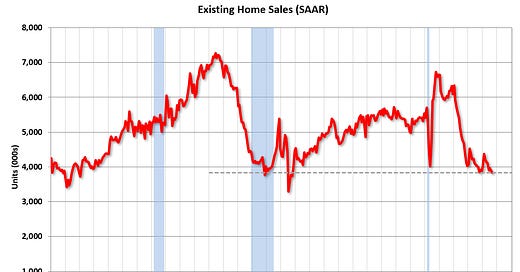NAR: Existing-Home Sales Decreased to 3.84 million SAAR in September, New Cycle Low
Median House Prices Increased 3.0% Year-over-Year
From the NAR: Existing-Home Sales Slid 1.0% in September
Existing-home sales drew back in September, according to the National Association of REALTORS®. Three out of four major U.S. regions registered sales declines while the West experienced a sales bounce. Year-over-year, sales fell in three regions but grew in the West.
Total existing-home sales – completed transactions that include single-family homes, townhomes, condominiums and co-ops – receded 1.0% from August to a seasonally adjusted annual rate of 3.84 million in September. Year-over-year, sales waned 3.5% (down from 3.98 million in September 2023).
...
Total housing inventory registered at the end of September was 1.39 million units, up 1.5% from August and 23.0% from one year ago (1.13 million). Unsold inventory sits at a 4.3-month supply at the current sales pace, up from 4.2 months in August and 3.4 months in September 2023.
emphasis added
The sales rate was below the consensus forecast (but at housing economist Tom Lawler’s estimate).
Sales in September (3.84 million SAAR) were down 1.0% from the previous month and were 3.5% below the September 2023 sales rate.
Housing Inventory Increased in September
The second graph shows nationwide inventory for existing homes.
According to the NAR, inventory increased to 1.39 million in September from 1.37 million the previous month.
Headline inventory is not seasonally adjusted, and inventory usually decreases to the seasonal lows in December and January, and peaks in mid-to-late summer. The third graph shows the year-over-year (YoY) change in reported existing home inventory and months-of-supply. Since inventory is not seasonally adjusted, it really helps to look at the YoY change. Note: Months-of-supply is based on the seasonally adjusted sales and not seasonally adjusted inventory.
Inventory was up 23.0% year-over-year (blue) in September compared to September 2023. Months of supply (red) increased to 4.3 months in September from 4.2 months the previous month.
Looking back to pre-pandemic levels, in September 2019 months-of-supply was at 4.0 months, so there is more supply now, on a months-of-supply basis, than prior to the pandemic! Even though inventory has declined significantly compared to 2019, sales have fallen even more - pushing up months-of-supply.
Sales Year-over-Year and Not Seasonally Adjusted (NSA)
The fourth graph shows existing home sales by month for 2023 and 2024.
Sales declined 3.5% year-over-year compared to September 2023. This was the thirty-seventh consecutive month with sales down year-over-year.
The following content is for paid subscribers only. Thanks to all paid subscribers!
Keep reading with a 7-day free trial
Subscribe to CalculatedRisk Newsletter to keep reading this post and get 7 days of free access to the full post archives.







